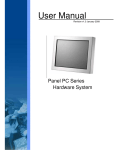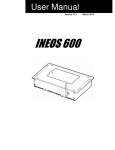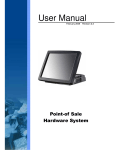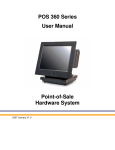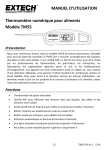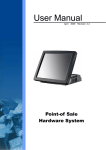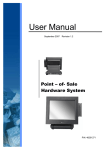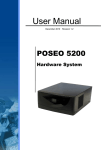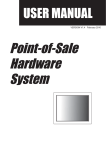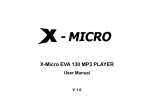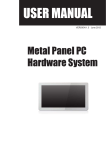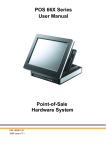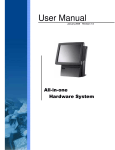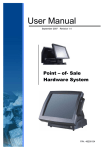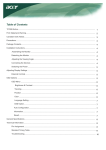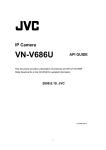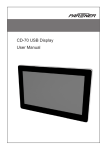Download K870 Series User Manual V1.3 3808KB Mar 23 2010 03:59:43 PM
Transcript
User Manual April 2009 Revision 1.3 Kiosk System Panel PC Series Copyright 2007~2009. All Rights Reserved Manual Version 1.3 The information contained in this document is subject to change without notice. We make no warranty of any kind with regard to this material, including, but not limited to, the implied warranties of merchantability and fitness for a particular purpose. We shall not be liable for errors contained herein or for incidental or consequential damages in connection with the furnishing, performance, or use of this material. This document contains proprietary information that is protected by copyright. All rights are reserved. No part of this document may be photocopied, reproduced or translated to another language without the prior written consent of the manufacturer. TRADEMARK Intel®, Pentium® and MMX are registered trademarks of Intel® Corporation. Microsoft® and Windows® are registered trademarks of Microsoft Corporation. Other trademarks mentioned herein are the property of their respective owners. Safety IMPORTANT SAFETY INSTRUCTIONS •Read these instructions carefully. Keep these instructions for future reference. •Follow all warnings and instructions marked on the product. •Do not use this product near water. •Do not place this product on an unstable cart, stand, or table. The product may fall, causing serious damage to the product. •Slots and openings in the cabinet and the back or bottom are provided for ventilation; to ensure reliable operation of the product and to protect it from overheating, these openings must not be blocked or covered. The openings should never be blocked by placing the product on a bed, sofa, rug, or other similar surface. This product should never be placed near or over a radiator or heat register, or in a built-in installation unless proper ventilation is provided. •This product should be operated from the type of power indicated on the marking label. If you are not sure of the type of power available, consult your dealer or local power company. •Do not allow anything to rest on the power cord. persons will walk on the cord. Do not locate this product where •Never push objects of any kind into this product through cabinet slots as they may touch dangerous voltage points or short out parts that could result in a fire or electric shock. Never spill liquid of any kind on the product. •The socket outlet should be installed near the equipment and should be easily accessible. CE MARK This device complies with the requirements of the EEC directive 2004/108/EC with regard to “Electromagnetic compatibility” and 2006/95/EC “Low Voltage Directive” FCC This device complies with part 15 of the FCC rules. Operation is subject to the following two conditions: (1) This device may not cause harmful interference. (2) This device must accept any interference received, including interference that may cause undesired operation 1 CAUTION ON LITHIUM BATTERIES There is a danger of explosion if the battery is replaced incorrectly. Replace only with the same or equivalent type recommended by the manufacturer. Discard used batteries according to the manufacturer’s instructions. LEGISLATION AND WEEE SYMBOL 2002/96/EC Waste Electrical and Electronic Equipment Directive on the treatment, collection, recycling and disposal of electric and electronic devices and their components. The crossed dustbin symbol on the device means that it should not be disposed of with other household wastes at the end of its working life. Instead, the device should be taken to the waste collection centers for activation of the treatment, collection, recycling and disposal procedure. To prevent possible harm to the environment or human health from uncontrolled waste disposal, please separate this from other types of wastes and recycle it responsibly to promote the sustainable reuse of material resources. Household users should contact either the retailer where they purchased this product, or their local government office, for details of where and how they can take this item for environmentally safe recycling. Business users should contact their supplier and check the terms and conditions of the purchase contract. This product should not be mixed with other commercial wastes for disposal 2 Table of Contents 1. Accessories ..................................................................................................................5 2. Components..................................................................................................................5 2.1 Front View ...........................................................................................................................5 2.2 Rear View ............................................................................................................................6 2.3 Button Cover View .............................................................................................................6 2.4 I/O Function ........................................................................................................................7 3. Specification .................................................................................................................8 4. Peripherals Installation ................................................................................................10 5. 4.1 Wall Mount Kit ....................................................................................................................10 4.2 MSR .....................................................................................................................................12 4.3 Laser Scanner Kit...............................................................................................................13 Jumper Settings ...........................................................................................................16 5.1 5.1.1 Motherboard layout .........................................................................................................................16 5.1.2 Connectors......................................................................................................................................17 5.1.3 Jumper Settings ..............................................................................................................................18 5.2 6. B78 V2.2 ..............................................................................................................................16 B98 V1.0 ..............................................................................................................................23 5.2.1 Motherboard layout .........................................................................................................................23 5.2.2 Connectors......................................................................................................................................24 5.2.3 Jumper Setting................................................................................................................................25 Drivers Installation .......................................................................................................30 6.1 B78 V2.2 ..............................................................................................................................30 6.1.1 Driver List ........................................................................................................................................30 6.1.2 Chipset Driver Installation ...............................................................................................................31 6.1.3 USB 2.0 Driver Installation..............................................................................................................32 6.1.4 VGA Driver Installation....................................................................................................................35 6.1.5 Audio Driver Installation ..................................................................................................................37 6.1.6 10/100/1000Mb LAN Driver Installation ..........................................................................................38 6.1.7 POSTouch Driver Installation ..........................................................................................................39 6.1.8 ELO Touch Driver Installation .........................................................................................................43 3 6.2 7. B98 V1.0 ..............................................................................................................................46 6.2.1 Driver List ........................................................................................................................................46 6.2.2 Chipset Driver Installation ...............................................................................................................47 6.2.3 VGA Driver Installation....................................................................................................................49 6.2.4 Audio Driver Installation ..................................................................................................................51 6.2.5 10/100/1000Mb LAN Driver Installation ..........................................................................................53 6.2.6 POSTouch Driver Installation ..........................................................................................................54 6.2.7 ELO Touch Driver Installation .........................................................................................................54 BIOS Settings................................................................................................................55 7.1 BIOS Setup Utility...............................................................................................................55 7.2 Starting the BIOS Setup.....................................................................................................55 7.3 When a Problem Occurs....................................................................................................55 7.4 BIOS Main Menu .................................................................................................................55 4 1. Accessories a. Power Cord (1) b. RJ45-DB9 Converter Cable (2) c. Driver CD (1) d. Power Brick (1) 2. Components 2.1 Front View Touch Screen LED Lens 5 2.2 Rear View Wall Mount HDD Cover 2.3 Button Cover Cable Cover Button Cover View Power Button Brightness Volume Brightness + Volume - 6 2.4 I/O Function LAN DC Jack MIC-In LINE-Out Cash Drawer COM (4) 7 USB (2) USB (2) LPT Power Switch 3. Specification Model Name K875 K877 Motherboard CPU Supports Chipset System Memory Graphic Memory B78 / B98 B78: Intel Celeron M 1.5GHz; Pentium M 1.6GHz/1.8GHz B98: Celeron M 1.86GHz;Core Due 2.0GHz;Core 2 Due 1.66GHz/2.16GHz B78: Intel 852GM and ICH4 FSB 400Mhz B98: Intel 945GME+ ICH7M B78: 2 x DDR SO-DIMM slot, up to 2 GB B98: 2 x DDRII SO-DIMM slot, up to 4 GB B78: Share system memory max 64MB B98: Share system memory max 244MB LCD / Touch Panel LCD Size 15" TFT LCD 17" TFT LCD Brightness 350nits 300nits 1024 x 768 1280 x 1024 Maximal Resolution Touch Screen Type Resistive type / SAW touch Storage HDD 2.5" Slim HDD bay, SATA HDD Expansion mini-PCI Slot 1, support 802.11 a/b/g WLAN card PCI express 1 for B98 main board only External I / O Ports USB 2.0 Serial / COM 4 x USB Type A RJ-45 (COM1 standard RS-232; COM2 RS-232 / 422 / 485 selectable by jumper; COM3 & COM4 pin 9 with 5V or 12V power by jumper Parallel 1 x D-sub 25F LAN (10/100/1000) 1 x RJ-45 Cash Drawer 1 x RJ-11 (12V or 24V) DC Jack 1 x Latch Type Audio Jack 1 x MIC-in, 1 x Line-out 8 Internal Interface USB 2.0 1 COM 2 (COM5: Touchscreen; COM6: Motion sensor) 2nd VGA 10-pin (2 x 5) header for CRT Audio Speaker 2 x 2W Speaker Control / Indicator Power Button 1 Indicator LED 1 x power LED IrDA 1 Motion sensor 1 Volume control button Up & Down Brightness control button Up & Down Power Power Adapter DC 19V / 90W Peripheral MSR Side mount ISO 3-tracks or JIS I&II moudle (Optional) Scanner Laser scanner (Optional) Environment EMC & Safety FCC Class A, CE, LVD Operating Temperature 0°C ~ 40°C (32°F ~ 104°F) Storage Temperature -20° ~ 60°C (-4°F ~ 140°F) Operating Humidity 5% - 95% RH non-condensing Storage Humidity 5% - 95% RH non-condensing Dust & Water Proof NEMA 4 / IP 65 (front) 386 x 330 x 65 mm 420 x 372 x 68 mm 15.2" x 13" x 2.6" 16.5 " x 14.6 " x 2.7 " N.W. 5.3kgs / 11.7 lbs N.W. 7.3kgs / 16.1lbs Dimension (W x D x H) Weight Mounting 75mm x 75mm & 100mm x 100mm Standard VESA Mount Hole Windows Vista for B98, Windows XP, WEPOS, XP Embedded, OS Support XP professional for Embedded, WIN 2000 professional Embedded, Linux ‧This specification is subject to change without prior notice. 9 4. Peripherals Installation 4.1 Wall Mount Kit 1. Put the wall mount kit bracket on the rear bezel. Tighten the screws (4). Screws Screws (2) 2. Tighten the screws (4) of the wall mount kit holder on the wall. 10 3. Hang the system on the wall mount kit holder. 4. Tighten the screw (2). Screw Screw (1) 11 4.2 MSR 1. Remove the screws (3). Screws 2. Slide the MSR cover out and disconnect the cable (1). Cable (1) 12 4.3 1. Laser Scanner Kit Assembly the Scanner Device and the metal Bracket. Align the 3 holes on the Metal Bracket into the right position of the Scanner Device and fix them by the screws (3). Metal Bracket Scanner Device Screws x 3 2. Connect the COM/USB Cable to the Scanner Kit. Connect the COM Connector to the Scanner Kit. COM /USB Cable 13 3. Assembly the Scanner kit to the System. Install the Scanner Kit in place as picture shows. 4. Fasten the Scanner Device. a. Connect the USB Connector to the System. b. Fasten the screws (2) to fix the Scanner and the System. COM Connector USB Connector Screw Holes 14 5. Front View of the Scanner Kit assembly onto the System. 15 5. Jumper Settings 5.1 B78 V2.2 5.1.1 Motherboard layout 16 5.1.2 Connectors Connector Function BAT1 CMOS Battery Base ( Use CR2023) CN1 Audio Line Out CN2 Audio MIC In CN3 Internal Power Switch CN4 Speaker & MIC Connector CN9 CD-IN Connector CN11 Power Connector For 3.5" HDD CN13 COM5 for Touch CN15 CPU FAN Connector CN16 Hardware Reset CN18 USB2 CN19 LCD Interface Connector CN20 Inverter Connector CN21 Card Reader Connector CN22 System FAN Connector CN23 IrDA Connector CN24 FT Status Interface CN26 Internal Power In Connector CN27 Internal LPT Connector CN28 Internal PCI Reset Output Connector IED1 Secondary IDE Connector (Pitch = 2.0mm) PRN1 Parallel Port PWR1 +19V Power Adaptor RJ11_1 Cash Drawer Connector RJ45_1 LAN (On Board) RJ45_2 COM1, COM2, COM3, COM4 SATA1 SATA Connector USB1 USB3, USB4 USB2 USB5, USB6 JP1 VGA Port JP2 VGA Power 17 5.1.3 Jumper Settings Location JP10 / JP9 1. COM2 RS232/485/422 Setting Function JP9 JP10 (1-2) (3-4) (5-6) (7-8) (9-10) (11-12) 1 3 5 7 9 2 4 6 8 10 1 3 5 7 9 2 4 6 8 10 1 3 5 7 9 2 4 6 8 10 11 (1-2) (3-4) (4-6) (5-7) (7-8) (9-10) 1 3 5 7 9 2 4 6 8 10 1 3 5 7 9 2 4 6 8 10 1 3 5 7 9 2 4 6 8 10 ◎RS232 12 11 RS485 12 11 RS422 ◎ = Default 18 12 2. COM3 & COM4 Power Setting JP3 Function (1-2) (3-4) (5-6) Location (7-8) (9-10) (11-12) 1 3 5 7 9 2 4 6 8 10 1 3 5 7 9 2 4 6 8 10 1 3 5 7 9 2 4 6 8 10 1 3 5 7 9 2 4 6 8 10 1 3 5 7 9 2 4 6 8 10 1 3 5 7 9 2 4 6 8 10 11 ◎RI COM3 Pin10 12 11 +5V 12 11 +12V 12 11 ◎RI COM4 Pin10 12 11 +5V 12 11 +12V ◎ = Default 19 12 Location JP3 3. Cash Drawer Power Setting JP4 Function (1-2) (3-4) (5-6) 1 3 5 2 4 6 1 3 5 Location +12V JP7 ◎+19V 2 4 JP4 6 ◎ = Default 4. LCD ID Setting Panel # LVDS Resolution Bits 1 2 3 4 5 640 800 1024 1280 1024 x x x x x 480 600 768 1024 768 18 18 18 24 24 20 JP7 Channel (1-2) (3-4) (5-6) (7-8) 1 3 5 7 2 4 6 8 1 3 5 7 2 4 6 8 1 3 5 7 2 4 6 8 1 3 5 7 2 4 6 8 1 3 5 7 2 4 6 8 Single Single Single Dual Single Panel # LVDS Resolution Bits 6 7 8 9 10 11 12 800 800 800 1024 1440 1280 1440 x x x x x x x 600 600 600 768 900 1024 900 24 18 18 24 24 24 18 21 JP7 Channel (1-2) (3-4) (5-6) (7-8) 1 3 5 7 2 4 6 8 1 3 5 7 2 4 6 8 1 3 5 7 2 4 6 8 1 3 5 7 2 4 6 8 1 3 5 7 2 4 6 8 1 3 5 7 2 4 6 8 1 3 5 7 2 4 6 8 Single Single Single Single Dual Dual Dual 5. Power Mode Setting Function JP6 (1-2) ◎ATX Power AT Power Location 6. CMOS Operation Mode Function JP8 (1-2) ◎CMOS Normal JP13 JP8 CMOS Reset JP14 7. JP6 USB Path Setting Function JP14 (1-2) ◎To Docking To M/B 8. System Indicator Function JP13 Function (1-2) (3-4) (5-6) (7-8) 1 3 5 7 2 4 6 8 1 3 5 7 2 4 6 8 ◎Disable Enable ◎ = Default 22 5.2 B98 V1.0 5.2.1 Motherboard layout 23 5.2.2 Connectors Connector Purpose BAT3 CN3 CN4 CN5 CN8 CN9 CN11 CN12 CN13 CN14 CN15 CN16 CN18 CN19 CN20 CN21 CN22 DDR2_A1 DDR2_B1 FAN_CPU3 FAN_SYS3 MINI_PCIE3 PCI3 PRN3 PWR3 RJ11_3 RJ45_3 RJ45_4 SATA1 SATA2 SKT1 SW3 USB3 USB4 JP9 JP10 CMOS Battery Base (Use CR2023) Audio Line Out MIC In Internal Power On Switch Connector Speaker & MIC Connector Internal LAN LED CD-IN / Line-In Connector LCD Interface Connector IrDA Connector Inverter Connector COM5 for Touch Power Connector For HDD USB5 Card Reader Connector FT Status Interface Connector Internal Input Power Connector Hardware Reset DDR2 SO-DIMM DDR2 SO-DIMM CPU FAN Connector System FAN Connector Mini PCI-E Socket Mini PCI Socket Parallel Port +19V Power Adaptor Cash Drawer Connector LAN (On Board) COM1, COM2, COM3, COM4 SATA Connector SATA Connector SPI ROM Power On Button USB1, USB2 USB3, USB4 VGA Port 2nd Display Power 24 5.2.3 Jumper Setting Location JP6 / JP4 1. COM2 RS232/485/422 Setting Function JP6 JP4 (1-2) (3-4) (5-6) (7-8) (9-10) (11-12) (1-2) (3-4) (4-6) (5-7) (7-8) (9-10) 1 3 5 7 9 11 2 4 6 8 10 1 3 5 7 9 2 4 6 8 10 1 3 5 7 9 2 4 6 8 10 1 3 5 7 9 2 4 6 8 10 1 3 5 7 9 2 4 6 8 10 1 3 5 7 9 2 4 6 8 10 ◎RS232 12 11 RS485 12 11 RS422 12 ◎ = Default 25 2. COM3 & COM4 Power Setting Function JP5 (1-2) (3-4) (5-6) (7-8) (9-10) (11-12) 1 3 5 7 9 2 4 6 8 10 1 3 5 7 9 2 4 6 8 10 1 3 5 7 9 2 4 6 8 10 1 3 5 7 9 2 4 6 8 10 1 3 5 7 9 2 4 6 8 10 1 3 5 7 9 2 4 6 8 10 Location 11 ◎RI COM3 Pin10 12 11 +5V 12 Location 11 +12V 12 11 ◎RI COM4 Pin10 12 11 +5V 12 11 +12V ◎ = Default 26 12 JP5 3. Cash Drawer Power Setting Function JP3 (1-2) (3-4) 5-6) 1 3 5 2 4 6 1 3 5 2 4 6 +12V Location ◎+19V JP8 ◎ = Default JP3 4. Boot Display Device Setting Function JP8 (1-2) (3-4) 1 3 5 7 2 4 6 8 1 3 5 7 2 4 6 8 1 3 5 7 2 4 6 8 1 3 5 7 2 4 6 8 Reserved Force CRT only Force LCD only Reserved 27 5. LCD ID Setting Panel # LVDS Resolution Bits 1 2 3 4 1024 1280 800 1024 x x x x 768 1024 600 768 24 Channel JP8 (1-2) (3-4) (5-6) (7-8) 1 3 5 7 2 4 6 8 1 3 5 7 2 4 6 8 1 3 5 7 2 4 6 8 1 3 5 7 2 4 6 8 Single 24 Dual 24 Single 18 Single Note: The Jumper setting for “Boot Display Device Setting” and “LCD ID Setting” are the same at Jumper JP8. 28 6. Power Mode Setting Function JP11 (1-2) ◎ATX Power Location AT Power 7. CMOS Operation Mode Function JP7 JP7 (1-2) JP11 ◎CMOS Normal JP12 CMOS Reset 8. System Indicator Function Function JP12 (1-2) (3-4) (5-6) (7-8) 1 3 5 7 2 4 6 8 1 3 5 7 2 4 6 8 ◎Disable Enable ◎ = Default Note: OPEN SHORT 29 6. Drivers Installation 6.1 B78 V2.2 6.1.1 Driver List Folder/File File Description <CD>:\ K870_B78.htm Driver List <CD>:\COMMON\INTEL\Chipset\i8xx Chipset Driver <CD>:\COMMON\INTEL\USB20 USB 2.0 Driver <CD>:\COMMON\INTEL\VGA\i85x VGA Driver <CD>:\COMMON\Ac97_codec\Realtek\ALC202A Audio Driver <CD>:\COMMON\ POS_Touch POSTouch Driver <CD>:\COMMON\ELO_Touch ELO Touch Driver <CD>:\COMMON\Lan_driver\Realtek_PCI 10/100/1000Mb LAN Driver -The following procedures are for Windows 2000/XP, other platforms are similar. 30 6.1.2 Chipset Driver Installation a. Double-click b. Click the “Next” button on the Welcome window. “infinst_enu_6.0.1.1007.exe” on the “My computer” window. c. Click the “Yes” button on the License Agreement window. d. Click the ”Next” button on the Readme Information window. e. Click the “Finish” button and restart your system. 31 6.1.3 USB 2.0 Driver Installation OS Requirements OS USB 2.0 requirements Windows XP USB 2.0 drivers are provided in Service Pack 1 (SP1) for Windows XP, which is available through Windows Update. Windows 2000 USB 2.0 drivers are available through Windows Update or Service Pack 4. Windows 98SE/Me USB 2.0 drivers are available on the Intel developer site. Windows 98 (Retail) Developers and OEMs should contact Orange Ware. For end-users, if your device does not ship with Windows 98 drivers, contact your device or system manufacturer. If USB 2.0 drivers are not available, your device will operate at USB 1.1 speeds Linux USB 2.0 support is available in kernel 2.4.19 or later development kernels, or in the 2.4.19 or later production kernel. More information. 32 a. Right click ”My Computer” on the desktop and select “properties” b. Select “Hardware”Æ”Device Manager” on system properties c. Select ”Other Devices” Æ “Universal Serial Bus (USB) Controller” Æ”Properties” on Device Manager d. Select “Device”Æ “Update Driver e. Click the ”Next” button on the welcome window. 33 f. Select “Search for a suitable…”and click the “Next” button on the Install Hardware Device Drivers window g. Select “Specify a location” and click the “Next” button on the Locate Driver Files window. h. Press “Browse” to select the driver and then click the “OK” button to go to the next page i. Click the “Next” button on the Driver Files Search Results window. j. Click the “Finish” button to complete this process. k. Finished. 34 6.1.4 VGA Driver Installation a. Double-click on “Win2K_XP” on the”My Computer” window. b. Double-click on “v14.19.50” c. Double-click on d. Click the “Next” button on the Intel(R) Chipset Graphics Driver SoftwareInstall Shield(R) Wizard window. “win2K_xp141950.exe” e. Click the “Next” button on the Intel(R) Graphics Media Accelerator Driver window. 35 f. Click the “Yes” button on the Intel(R) Graphics Media Accelerator Driver window. g. Select “Yes, I want to restart my computer now” and click the “Finish” button on the Intel(R) Graphics Media Accelerator Driver window. 36 6.1.5 Audio Driver Installation a. Double-click “A3.71” on the My Computer window. b. Double-click “wdm_a371.exe” on the My Computer window. c. Click “Next” button on the Realtek AC’97 Audio Setup window. d. Click “Yes” button on the Digital Signature Not Found window. e. Click “Finish” button on the Realtek AC’97 Audio Setup window. 37 6.1.6 10/100/1000Mb LAN Driver Installation a. In the “Realtek RTL8110“ section, click on “Win9X, ME, 2K, XP“. b. Double-click ”v709” c. Double-click ”Setup.exe”. d. Click the ”Finish” button on the Maintenance Complete window. e. Click the ”OK” button and restart your system. 38 6.1.7 POSTouch Driver Installation Below POSTouch Driver Installation is for the Motherboards B78 V2.2 and B98 V1.0. a. In the ”POSTouch” section, click ”Windows”. b. Double-click on ”v3.3.1.30”. c. Double-click ”Setup”.exe. d. Click ”Next”. e. Select ”I agree… and click ”Next”. f. Select the installation folder for the touch utility driver and click ”Next”. 39 g. Select the shortcut folder for the touch h. Click ”Next” utility driver and click ”Next”. i. Click ”Next”. j. The computer is installing the touch driver k. Click ”Continue Anyway”. l. The serial ports are scanned for a touch device. The Touch panel is on ”COM5”. 40 m. Click “Finish”. n. Click “OK” to restart the computer and finish the touch utility installation. o. The computer has restarted. Click on the Start button, select Programs, then select Touchutility. p. Select the “Device” tab. q. Click on the 3 points or the 9 points calibration button. r. Follow the instructions on the screen to do the calibration of the touch panel 41 s. Touch the screen to save the calibration 42 6.1.8 ELO Touch Driver Installation Below ELO Touch Driver Installation is for the Motherboards B78 V2.2 and B98 V1.0. a. In the “ELO” section, click on “Windows”. b. Click “OK”. c. Click ”Unzip” to extract the driver to the specified folder. d. Finished unzipping. Click ”OK”. e. Click ”Next”. f. Check the box Install Serial Touchscreen Drivers and click ”Next”. 43 g. Click ”Yes” to accept the End User License Agreement h. Examining serial ports on the computer i. Check the box Auto-detect Elo j. The computer is searching for a connected to Elo Touchscreen devices and click ”Next”. k. Touchscreen found on ”COM5”. Click ”Next”. l. Click ”Next” to complete the driver installation 44 m. Driver is installing n. The driver installation and setup are now complete. Click ”Finish” to start the touchscreen calibration. o. Follow the instructions on the screen to calibrate the Touchscreen. p. Verify that the touchscreen is working correctly by moving your finger on the screen. The mouse cursor should follow your finger. Finally, touch the green checkmark to save the calibration settings and exit the program 45 6.2 B98 V1.0 6.2.1 Driver List Folder/File File Description <CD>:\K870_B98.htm Driver List <CD>:\COMMON\INTEL\Chipset\i9xx Chipset Driver <CD>:\COMMON\INTEL\VGA\i94x VGA Driver <CD>:\COMMON\Audio\Realtek_HD_Codec Audio Driver <CD>:\COMMON\ POS_Touch POSTouch Driver <CD>:\COMMON\ELO_Touch ELO Touch Driver <CD>:\COMMON\Lan_driver\Realtek_PCIe 10/100/1000Mb LAN Driver -The following procedures are for Windows 2000/XP, other platforms are similar. 46 6.2.2 Chipset Driver Installation a. In the ”Chipset” section, click on “Windows“. b. Double-click ”v8.3.0.1013”. c. Double-click d. Click ”Next”. ”infinst_autol_V8.3.0.1013.exe”. e. Click ”Yes”. f. Click ”Next”. 47 g. The driver installation starts… h. Click ”Next”. i. Click ”Finish” to restart the system. 48 6.2.3 VGA Driver Installation a. In the VGA section, click b. Double-click ”v14.32.3”. on ”Win2K_XP”. c. Double-click ”win2k_xp14323.exe”. d. Click ”Next”. e. Extracting files… f. Click ”Next”. 49 g. Click ”YES” to accept the license agreement h. Click ”Next”. i. Click ”Next”. j. Select ”Yes... ”and click ”Finish” to restart the computer 50 6.2.4 Audio Driver Installation a. In the Realtek HD Codec section, click b. Double click on ”v1.85”. on ”Win2K, XP, 2003”. c. Double-click ”WDM_R185.exe”. d. Driver files are extracted… e. Click ”Next”. f. The computer is installing the Audio HD driver. 51 g. Select “Yes, I want to restart my computer” and click ”Finish”. 52 6.2.5 10/100/1000Mb LAN Driver Installation a. In the Realtek RTL8111 section, click b. Double-click ”v686”. on ”Win9X, ME, 2K, XP”. c. Double-click ”Setup.exe” d. Click ”Next”. e. Click ”Install” to begin the driver installation. f. The driver is being installed… 53 g. Click ”Finish” to complete the installation. 6.2.6 POSTouch Driver Installation POS Touch Driver Installation for B98 V1.0, please refer to B78 V2.2 POSTouch Driver Installation on page 39. 6.2.7 ELO Touch Driver Installation ELo Touch Driver Installation for B98 V1.0, please refer to B78 V2.2 ELO Touch Driver Installation on page 43. 54 7. BIOS Settings Below BIOS Settings are for the Motherboards B78 V2.2 and B98 V1.0. 7.1 BIOS Setup Utility The BIOS setup defines how the system is configured. You need to run this program the first time you configure this product. You may need to run it again if you change the configuration. You need to connect a PC keyboard to the keyboard connector to run the BIOS setup utility. 7.2 Starting the BIOS Setup Turn on or reboot this product. Press the DEL key immediately after the product is turned on, or press the DEL key when the following message is displayed during POST (the Power on Self-Test) Press DEL to enter SETUP. The main menu of the BIOS setup is displayed. If the supervisor password is set, you must enter it here. 7.3 When a Problem Occurs If, after making and saving system changes with the Setup utility, you find that this product no longer boots, start the BIOS setup and execute the following Load Optimized Defaults 7.4 BIOS Main Menu When the BIOS Main Menu is displayed, the following items can be selected. Use the arrow keys to select items and the Enter key to accept and enter the sub-menu. Note: The BIOS setup menus shown in this section are for reference only and may not exactly match the items of your BIOS version. . 55 Standard CMOS Features Use this menu for basic system configuration. Advanced BIOS Features Use this menu to set the Advanced Features available on the system. Advanced Chipset Features Use this menu to change the values in the chipset registers and optimize the system’s performance. Integrated Peripherals Use this menu to specify your settings for integrated peripherals. Power Management setup Use this menu to specify your settings for power management. PnP/PCI Configurations This entry appears if your system supports Plug and Play and PCI Configuration. PC health status Displays CPU, System Temperature, Fan Speed, and System Voltages Value. Load Optimized Defaults Use this menu to load the BIOS default values, i.e., factory settings for optimal performance system operations. While Award has designed the custom BIOS to maximize performance, the factory has the option to change these defaults to meet their needs. Set Supervisor Password Enables you to change, set, or disable the supervisor or user password. Set Password Change, set, or disable the password. It allows you to limit access to the system and to the setup, or just to the setup. Save & exit setup Save CMOS value changes to CMOS and exits setup. Exit without saving Ignores all CMOS value changes and exits setup. 56


























































